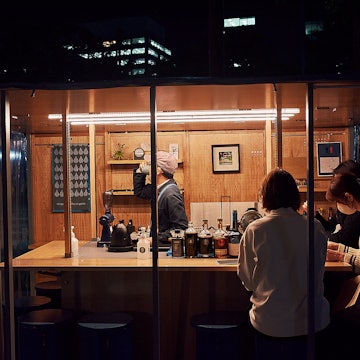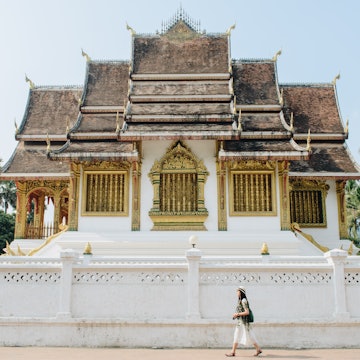

Cycling is a great way see Taiwan and to get around for next to nothing © iStockphoto / Getty Images
You can definitely travel cheaply in Taiwan, and with some planning, it can be immensely enjoyable.
That said, Taiwan is not as budget-friendly as Vietnam, Malaysia or Indonesia, though it is more affordable than Singapore, Hong Kong and Japan.
Accommodation costs are relatively high, but this is more than compensated for by abundant cheap and delicious food, inexpensive public transport, free entry to stellar attractions, exceptional hiking for little-to-no cost and free festivals all year round. Here are all the tips and tricks you need to visit Taiwan on a budget.
Take the metro or bus from the airport
Taoyuan International Airport is Taiwan’s gateway to the world; the other major international airport is in Kaohsiung. Buses, departing every 15 minutes to an hour, offer the cheapest rides (NT$90 to NT$145) to downtown Taipei from Taoyuan International Airport. Depending on the drop-off point, the ride can take anywhere from 50 to 80 minutes.
For just a little bit more (NT$160), the Airport MRT whizzes you to the city center in under 40 minutes, with trains arriving like clockwork every 10 minutes.
From Kaohsiung International Airport, a 15-minute metro ride to the metropolitan area is NT$35. Buses are more expensive and slightly slower.

Get the EasyCard
The convenient EasyCard is a contactless smartcard used mostly to pay for rides on public transport and store purchases. It costs NT$100 plus a top-up amount of your choice. Using the card doesn’t save you money per journey, but small discounts of under NT$10 apply when you transfer between metro and bus, or between metro and Youbike, the public bike-sharing service.
Consider downloading transport apps
Download transport apps to compare routes and prices ahead of time. Some handy ones are the government’s bilingual train, high-speed rail, and metro apps. The bus apps are useful too, although Google Maps works just as well in Taiwan.
Fill your days with free attractions
You’d struggle to run out of free attractions no matter how long you stay. All of Taiwan’s 15,000 temples, from nature worship to Unesco-award winning, are free to visit.
While most major museums charge an entrance fee, the Museum of Fine Arts, Museum of Taiwan Literature and Human Rights Museum are among the worthy exceptions.
Art centers and art villages are free, as are nature reserves and salt fields. A five-minute NT$30 ferry ride from Kaohsiung takes you to Cijin Island, where history, a beautiful beach and a killer sunset await.
Strategize your use of public transport
Depending on the city, any combination of bus, metro, public bike and walking will likely be your cheapest and most efficient way to get around. For example, you can combine walking with riding a public bike to explore the metropolitan area of Tainan.
Buses are cheaper and connect you to more destinations than the MRT, and in small cities without a metro, they are a budget traveler’s best friend. Bus fares in Taipei and Kaohsiung are calculated using a fare zone system that charges NT$15 and NT$12 per zone, respectively.
Slightly costlier than buses at NT$20 to NT$65 per journey, the metro has the added benefit of giving respite from the heat and traffic jams. Public shared bikes called Youbike or T-bike are wonderful for shorter distances and sightseeing. Rates vary, but the average is NT$10 an hour.
Have your kids travel on your lap on the trains
Children under six (or 115cm/3ft 9in) can ride the MRT for free. Same for high-speed rail and intercity trains, provided you hold them on your lap. If your child needs a seat, buy a children’s ticket – half-price for kids between six and 12 years (or 115cm to 150 cm/3ft 9in to 4ft 9in).

Go hiking, biking, and hot-springing
Taiwan is home to hundreds of hiking trails, from paths in urban parks to roads through ancient forests. The vast majority are free and accessible by public transport, but keep in mind that entry to certain high-mountain areas requires a permit.
If you intend to explore Taroko National Park, consider purchasing a day pass (NT$250) to bus-hop among trails and natural wonders. Cycling is also popular, and the island is crisscrossed by cycling lanes, routes and bikeways, all free as the breeze.
Taiwan is one of Asia’s top hot-spring destinations. You can combine hiking with a soak in a scenic wild spring. Yangmingshan has free public pools that have soothed many weary hikers’ soles. In the Beitou hot-spring resort area, Beitou Public Hot Spring offers the cheapest dips (NT$40).
Take the slow train if you have time
Taiwan’s two rail systems – HSR (high-speed rail) and TRA (Taiwan Railway Administration) – are both safe, clean and punctual. TRA has three types of trains with different speeds, fares and frequencies. The fastest are less frequent than the other two and have costlier tickets that sell out quickly.
As a rule of thumb, HSR is about twice as fast and expensive as TRA. For example, an HSR journey from Taipei to Kaohsiung costs NT$1490 and takes two hours, whereas the same on the second-fastest type of TRA train would cost NT$845 and take five hours.
Get your caffeine fix from convenience stores or local chains
The cheapest coffee can be had at convenience stores. Don’t turn your nose up yet; two of the chains, FamilyMart and 711, sell freshly brewed specialty coffees. The local cafe chains Cama Café and Louisa Coffee also make a pretty good cup of joe (as well as fancy matcha latte and affogato) for way less than Starbucks.

Eat at the markets
Taiwan is teeming with cheap eats that deliver, so you don’t need to sacrifice variety for economy. Taipei’s bento restaurants and noodle shops can feed you well for only NT$80; even less in Kaohsiung and Tainan.
But for a unique experience, visit a night market. Every city has at least a couple. The sheer array of affordable food at these street bazaars, from fried mackerel to fruit smoothies, means you can munch away without crunching numbers.
Stalls inside produce markets, open for breakfast and lunch, are great for a quick meal. Plus, you can pick up some fruits on your way out. One of the best is Tainan’s Yongle Market, a grazer’s paradise.
Make use of water dispensers
Bring your water bottle. Water dispensers are almost as ubiquitous as convenience stores. You’ll find them in all metro and train stations, museums, temples, libraries, information centers, hostels and hotels. If you need hot water for tea or coffee, all lodgings provide a kettle.
Book a reliable hostel or hotel
Accommodation costs are relatively high in Taiwan, compared to food and transport. The cheapest sleeps – other than the odd Catholic hostel or temple guest room – are hostel dorms which can be had for NT$500-$800 per night for six to ten-bunk rooms, sometimes slightly lower mid-week.
If you want privacy, private rooms in hostels can be found for NT$1,600-2,200 per night. Some older two-star hotels may charge you 20% less, making them a better option if money is the main concern.
If it isn’t, do more research, as quality can be random. Some hostels are a steal, others not. Likewise, hotels. In general, cheaper hotels tend to have spacious rooms but tired furniture.

Buy beer from convenience stores
Convenience stores are ubiquitous in Taiwan, allowing you to buy beer to drink in the park, by the river watching the sunset or in-store (many have tables and seats).
They also sell chilled meals (that they can reheat for free), sandwiches, tea eggs, roasted sweet potatoes, rice balls, cup noodles (with free hot water if needed), fruit and ice cream. It's way cheaper than hitting a pub, and the quality is reasonable.
Join the locals at a traditional festival
Throughout the year, there’s always a festival or a deity’s birthday parade just around the corner. Some, like the Mazu Pilgrimage, the Burning of the Wang Yeh Boats and the Yanshui Beehive Fireworks Festival, are spectacular once-in-a-lifetime experiences that you’d probably pay to see – but they won't cost you a dime.
Daily Costs
Hostel dorm: NT$500–800
Basic room for two: NT$1200–2200
Self-catering apartment (including Airbnb): NT$1100-4800
MRT ticket: NT$40
Coffee: NT$60
Noodles and side dish: NT$80–180
Dinner for two: NT$500-1000
Beer/pint at the bar: NT$200














